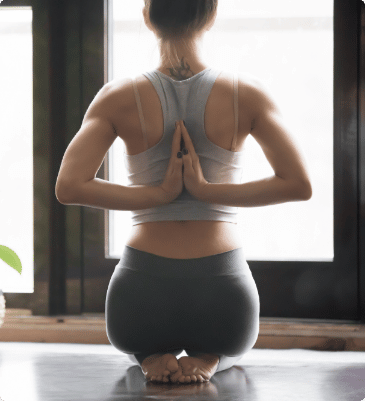How Can I Straighten My Spine?
It’s normal to catch yourself slouching throughout the day. However, if you’d like to learn how to correct this bad habit, straighten your back, and practice better posture, Upright Pose is here to help. We make it simple for you to straighten your spine by offering educational resources and products designed to teach you better habits and help you practice good posture basics.
Follow these tips to learn how to get a straight back, reduce back and neck pain, and avoid unnecessary strain or tension.My Back Is Bent.
How Do I Make It Straight?
By practicing good posture, breathing, stretching, and body awareness, you can start to straighten your spine through consistency and the development of better habits. Take notice of how you handle yourself when you are walking, sitting, and standing. Are there times when your posture is noticeably worse than at other times? Are there factors that cause further aggravation? Conversely, at what times during the day are you more aware of your posture? What helps you focus on and practice keeping your back straight?
By taking the time to pay attention to these details throughout the day and by putting in daily effort, you can create a plan to work on your posture when you notice difficulties, and you will start to notice more spine strength and normalcy in your posture. Keep reading to learn how to get a straight back.
RELATED ARTICLE

How to Straighten Back Posture
Next, begin by stretching to loosen up your muscles — simple stretches like toe touches and shoulder rolls are a great way to start. The best way to establish this in your daily routine is to do it first thing in the morning after you wake up. Next, evaluate how your head, shoulders, and spine are positioned while doing everyday tasks that require standing, sitting, and walking.
Standing
- Focus on your head placement — Your head should be centered over your spine, not pushed forward.
- Don’t stick your chin out — Tuck in your chin so your chin (and head) is kept level to the ground.
- Hold your shoulders straight — Keep your shoulders held tall and straight, but don’t push your chest out.
- Let your arms hang down —Keep your arms hanging naturally at your sides.
- Keep your back relaxed — Straighten your back and let go of any tenseness.
- Hold your hips in alignment — Keep your hips naturally in line with your spine, and make sure they don’t jut in or out too much. Don’t let your glutes stick out.
- Bend your knees — Bend your knees slightly to remove some of the pressure on your hips.
- Stand with your feet evenly spaced apart — Keep your feet in line with your shoulders. If you are standing for a longer period of time, rotate your weight between your feet. Make sure your shoes fit well and offer good support.

Walking
Good mechanics for walking are similar to the techniques above for standing. First, make sure you have the proper footwear. Heels, flip-flops, and slippery soled shoes don’t have the proper structure to encourage good posture. Strong support starting at your feet will lay the foundation for proper spine alignment all the way to your head. Once you have the proper footwear, pay attention to the following while walking:

- Walk in a heel-toe formation.
- Look straight ahead to where you are walking so your head remains level to the ground.
- Focus on the shoulder and hip placement — keep relaxed but still focus on remaining elongated and straight in the spine.
- Keep your head in line with your spine, not pushed forward.
Sitting
Between driving, working, and watching TV, a majority of your day can easily be spent in a sitting position. This offers ample opportunities for you to practice straightening your back while in this position. Consider the following as you sit:
- Align your back with the back of your chair or seat.
- Keep your arms bent comfortably at a 75-90-degree angle.
- Don’t slouch or hunch your shoulders over.
- Place feet flat on the ground.
- If working at a computer, keep the monitor at eye level so your head is level with the ground.
- Get up to move or stretch and change your position regularly.

By taking care of your posture while sitting, you’ll relieve back and neck pain and reduce headaches.
Sleeping
If you’re not standing, sitting, or walking, chances are you are laying down. Even as you sleep, you can practice good spinal alignment that minimizes unnecessary strain. Try practicing the following as you sleep to improve comfort and posture:

- Sleep on your back — This is the optimal sleeping position. Sleeping on your stomach places extra strain on your neck and shoulders. If you sleep on your side, use a pillow between or under your knees to keep your back in good form.
- Use pillows for support — Place a pillow under your knees or the small of your back for greater spinal support.
- Only use one head pillow — Sleeping with too many pillows bends your neck uncomfortably and disrupts proper alignment.
By consistently practicing the techniques listed above, you will notice better posture habits over time. Practice and consistency are the keys to success, and soon, these good habits will be second nature to you.
If you’d like to learn more about how to straighten back posture, Upright Pose can help. Check out our upright posture guide or view our products page to learn more about the latest tools and technology related to straightening your back.
More Posts About Good Posture
Revisit the GO 2/S Device Setup
Hi there! Here you’ll be able to see all the steps you once went through the first time you set up your GO. Let’s take a look! Turn on & connect The first step to
How to get started
Just got your UPRIGHT GO? Here’s what you need to do
Finding your upright position
Watch this video to learn how to find your target upright position
How to find your target upright posture
Before you calibrate your GO, for example
